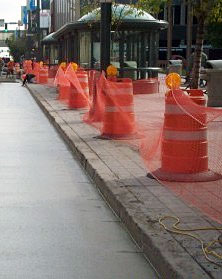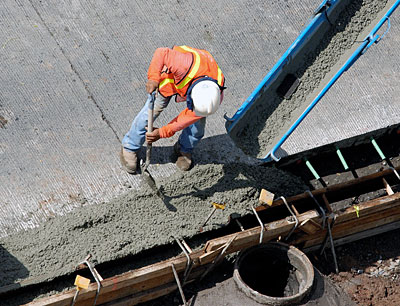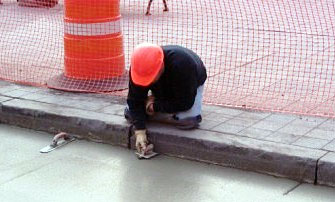Curbs and Gutters
Curb Construction
Advantages | Types | Requirements | Design | AASHTO Standards | Joints | Drainage | Materials | Construction
Testing for Quality | Curing | Joint Cutting | Backfilling
Like concrete pavements, curbs are constructed with traditional forms or slipform equipment, separately or along with the construction of concrete pavements. The procedures for efficient and economical construction of concrete curbs are practically parallel to those for concrete streets and roads. These include the preparation of the subgrade to provide uniform support, the accurate alignment of forms or slipform equipment, the placing and consolidating of durable concrete, jointing for crack control, finishing and texturing, curing, and protecting until ready for traffic loads.
 The subgrade for curbs may be prepared separately, but it is preferable to prepare the subgrade for streets and curbs simultaneously in order to take advantage of the efficiency and effectiveness of larger equipment and to establish uniform support. After any underground utilities and sub-surface drainage features are installed and properly backfilled, subgrades should be carefully compacted to specified densities with controlled moisture. 95% of standard Proctor density is usually specified. In some cases, separate curbs are designed to extend to the bottom of the pavement structure, but where there are granular drainage courses or subbases, they should carry through under the curbs. Where there are compacted aggregate bases at lower elevations than curb bottoms, the bases should extend under the curbs and far enough beyond to support the curb construction equipment. Besides the curbs themselves, curb forms and curb slipform machines need firm support to produce straight, stable curbs at the specified elevations.
The subgrade for curbs may be prepared separately, but it is preferable to prepare the subgrade for streets and curbs simultaneously in order to take advantage of the efficiency and effectiveness of larger equipment and to establish uniform support. After any underground utilities and sub-surface drainage features are installed and properly backfilled, subgrades should be carefully compacted to specified densities with controlled moisture. 95% of standard Proctor density is usually specified. In some cases, separate curbs are designed to extend to the bottom of the pavement structure, but where there are granular drainage courses or subbases, they should carry through under the curbs. Where there are compacted aggregate bases at lower elevations than curb bottoms, the bases should extend under the curbs and far enough beyond to support the curb construction equipment. Besides the curbs themselves, curb forms and curb slipform machines need firm support to produce straight, stable curbs at the specified elevations.
Curb forms should be straight, clean, and adequately interlocked and braced to hold to designed lines and grades. This is especially critical for combined curbs and gutters in order to assure the gutters will drain efficiently. It is also critical for tall straight curbs whose forms must be stable to maintain lines and elevations. Steel forms are preferred to wood forms because of their greater stability, but wood forms can be used for small projects and for curved sections if enough stakes and braces are employed. Forms should be sprayed with a release agent prior to placing the concrete, but the release agent should not be allowed on the reinforcing steel, if used. While the backs of formed curbs are usually vertical, exposed portions of front faces are often sloped or battered. Sloping formed faces require spacers or templates to maintain correct cross sections and are therefore more difficult to form. Slipformed curbs, on the other hand, are preferably constructed with battered or sloping back and front faces for greater stability, faster placement and more efficiency. It is not uncommon to have gaps or short sections in slipformed curbs filled in with formed sections. In these instances, it is important that the formed sections match the slipformed sections in cross-sections and textures.
Reinforcing steel in concrete curbs is not usually necessary or recommended if correct jointing is used. However, if formed curbs are to be reinforced with steel bars, the bars should be positioned and secured within the forms so that they will not be displaced during placement and consolidation of the concrete. The deformed bars should not extend through expansion joint material placed at tangents of radii, but should extend through any spacer plates used to hold the forms in position. In reinforced slipformed curbs, the reinforcing bars are laid out in front of the slipform machines and fed through positioning plates in the fronts of the machines as they advance. Reinforcing bars must be lap spliced appropriate lengths to develop continuity and the laps should be tied to keep them in place, unless ties would interfere in slipform operations.
 Concrete can be placed directly from ready mixed concrete trucks into forms or into hoppers of slipform curb machines. The ready mixed concrete trucks usually operate on the subgrades of the streets being constructed, but if compacted aggregate base is already in place, precautions should be taken to avoid having the delivery trucks disturbing the compacted surface or tracking soil on to the base. If delivering ready mixed concrete trucks are to operate behind the curbs, it is essential that any underground utilities or sub-surface drainage trenches behind the curbs have been properly backfilled. As the low slump concrete required for curb and gutter construction is susceptible to stiffening rapidly, it is important to schedule the concrete delivery so that there is no delay in discharging the concrete from the ready mixed concrete trucks when they arrive at the site.
Concrete can be placed directly from ready mixed concrete trucks into forms or into hoppers of slipform curb machines. The ready mixed concrete trucks usually operate on the subgrades of the streets being constructed, but if compacted aggregate base is already in place, precautions should be taken to avoid having the delivery trucks disturbing the compacted surface or tracking soil on to the base. If delivering ready mixed concrete trucks are to operate behind the curbs, it is essential that any underground utilities or sub-surface drainage trenches behind the curbs have been properly backfilled. As the low slump concrete required for curb and gutter construction is susceptible to stiffening rapidly, it is important to schedule the concrete delivery so that there is no delay in discharging the concrete from the ready mixed concrete trucks when they arrive at the site.
Concrete placed in forms can be struck off manually or by form riding machines. Concrete must be consolidated to avoid honeycomb and voids and it must be shaped to the proper cross sections. When finished manually, curb and gutter sections are shaped by drawing straightedges across templates or by mules shaped to be pulled along the tops of the forms. Curbs and gutters can be checked for drainage by covering them with burlap and carefully pouring water into the gutters to be sure there are no flat spots. Curbs and gutters should be textured with light broom finishes or by dragging wet burlap or artificial turf along the surfaces.
Testing for Quality
Concrete used in curbs should be tested for quality according to the requirements in ASTM C-94 at least once per day or once every 150 cubic yards of concrete delivered to a job site. Since curbs and curb and gutter sections may require less than one cubic foot per foot of length, 150 cubic yards can represent a very long length of curb, and more frequent testing may be desired, especially in hot weather. Tests may include checking for entrained air (ASTM C 231 or C 173), slump (ASTM C 143), temperature (ASTM C 1064), unit weight (ASTM C 138), and compressive strength (ASTM C 39). Concrete should be sampled according to ASTM C 172. The flexural strength tests should not be used for quality control. Slump tests are irrelevant for concrete that is successfully passing through a slipform curb machine. Assuming an approved mixture design produces concrete of a satisfactory quality, the main purpose for performing quality control tests during construction is to confirm uniformity of production. If the consistency of the delivered concrete is satisfactory for efficient placement, the most useful quality control test is the unit weight test. This test is relatively easy and quick to perform and it will quickly detect changes in entrained air content and other variations in quality. Changes in unit weight should be investigated by testing for entrained air. ACI Certified Testing Technicians should perform the field sampling and testing.
Curing
As soon as concrete has been placed and finished, it must be cured to develop strength and durability. This important construction operation is essential in achieving the required properties of concrete and it must be carried out on the job site as specified or in accordance with acceptable standard industry practices. Curbs must be protected against loss of moisture, from rain damage, from traffic, and from extreme hot or cold temperatures. ACI 308, Standard Practice for Curing Concrete, is a valuable source of information on taking care of concrete after it has been placed. In normal construction weather, protection can be accomplished by completely covering all exposed surfaces with spray-on membrane curing compound. In extremely dry conditions with high temperature, low humidity and wind, recommendations in ACI 305R, Hot Weather Concreting, should be carefully followed to avoid plastic shrinkage cracking and other ill effects. In cool weather with high humidity, it may not be necessary to use curing compound, but changes in weather should be watched to be sure the concrete is protected adequately. In cold weather, concrete must be kept warm enough to develop its strength and durability, and recommendations in ACI 306R, Cold Weather Concreting, should be carefully followed.
Joint Cutting
 Joint locations should be spaced with consideration for places that will affect curb movement as previously discussed, such as sharp curves and interruptions for inlets. Sawing is the preferred way to cut joints because it is difficult to tool joints to adequate depths in thick sections. However, joints have been impressed into curbs with tee-bars shaped to conform to the curbs' cross-sections. Sawing should be done as soon as possible without spalling the edges of the saw cuts. Forms must be removed in order to saw joints properly. Removal of the forms means that the front and rear surfaces of the curbs must be protected against drying as well as the saw cuts.
Joint locations should be spaced with consideration for places that will affect curb movement as previously discussed, such as sharp curves and interruptions for inlets. Sawing is the preferred way to cut joints because it is difficult to tool joints to adequate depths in thick sections. However, joints have been impressed into curbs with tee-bars shaped to conform to the curbs' cross-sections. Sawing should be done as soon as possible without spalling the edges of the saw cuts. Forms must be removed in order to saw joints properly. Removal of the forms means that the front and rear surfaces of the curbs must be protected against drying as well as the saw cuts.
Backfilling
Curbs should be carefully backfilled as soon as they have enough strength to resist displacement and damage from the operations of grading and compacting. Backfilling protects the front and backsides of curbs, provides damp earth to supplement curing or other protective measures, and protects curbs and new pavements from undercutting by runoff. If rainfall is expected soon after curbs are constructed, it is advisable to protect the backs of curbs with temporary berming or diversion channels to avoid undercutting that is difficult to repair or may even lead to failure of new curb sections.


